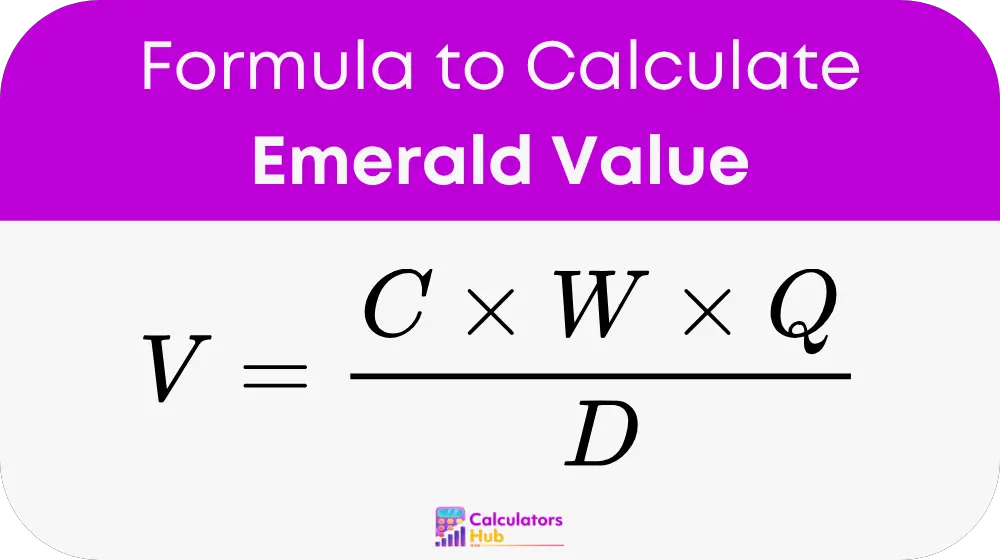The Emerald Value Calculator is a tool designed to estimate the value of an emerald based on various key factors such as color, weight, quality, and condition. Emeralds, like other precious gemstones, are valued differently depending on several criteria, and this calculator helps users evaluate the worth of an emerald accurately by considering these factors in a structured formula. The Emerald Value Calculator is commonly used by jewelers, collectors, and investors to assess the value of emeralds for purchasing, selling, or insurance purposes.
Emeralds are unique in that their value is not only determined by their size but also heavily influenced by their color, clarity, and condition. The Emerald Value Calculator uses these variables to provide an estimated price for the gemstone, helping individuals make informed decisions about their emerald purchases or sales.
Formula of Emerald Value Calculator
The formula for calculating the value of an emerald is as follows:

Where:
- V = Estimated value of the emerald (in dollars, adjusted by market rates)
- C = Color grade (numerical value based on hue, saturation, and tone)
- W = Weight in carats
- Q = Quality factor (numerical value reflecting clarity and cut)
- D = Depreciation factor (accounts for age, wear, or condition)
This formula incorporates the four primary elements that determine the value of an emerald: color, weight, quality, and condition. The values for each factor are determined based on established grading systems in the gemstone industry.
Value Tables
Here are detailed tables for each of the factors used in the formula:
1. Color Grade (C)
Color is one of the most critical factors in emerald valuation. Emeralds with vivid, medium-dark bluish-green hues tend to be the most valuable. The table below assigns numerical values to color grades:
| Color Grade | Description | Numerical Value (C) |
|---|---|---|
| A | Vivid, medium-dark bluish-green, top-tier | 4.0 |
| B | Good saturation, slightly lighter/darker | 3.0 |
| C | Moderate saturation, less vibrant | 2.0 |
| D | Pale, overly dark, or yellowish-green | 1.0 |
2. Quality Factor (Q)
The quality factor takes into account the clarity of the emerald, with “inclusions” often called “jardin” in the industry, and the cut quality, which impacts the brilliance and proportions of the emerald. The table below shows the different levels of quality for emeralds:
| Quality Level | Clarity Description | Cut Description | Numerical Value (Q) |
|---|---|---|---|
| High | Minimal visible inclusions (VS-VVS) | Excellent proportions, high brilliance | 3.0 |
| Medium | Moderate inclusions (SI1-SI2) | Good proportions, decent brilliance | 2.0 |
| Low | Heavy inclusions (I1-I3), cloudy | Poor proportions, low brilliance | 1.0 |
3. Depreciation Factor (D)
The depreciation factor accounts for the emerald’s age, wear, damage, or any treatments it may have undergone. A value of 1.0 indicates no depreciation, and higher values indicate greater wear or damage.
| Condition | Description | Numerical Value (D) |
|---|---|---|
| Excellent (No Depreciation) | No visible wear, minimal/no treatments | 1.0 |
| Good | Minor wear, light treatments (e.g., oiling) | 1.2 |
| Fair | Noticeable wear, moderate damage/treatments | 1.5 |
| Poor | Significant damage, heavy treatments, or cracks | 2.0 |
Common Search Terms and Helpful Conversion Table
To help users better understand the terms used in the Emerald Value Calculator, here’s a table with common terms and their definitions, which can be helpful when performing a value calculation:
| Term | Description |
|---|---|
| Carat Weight | The weight of the emerald, measured in carats. One carat is equal to 200 milligrams. |
| Color Saturation | The intensity of the emerald’s green hue. The more intense the green, the more valuable the emerald. |
| Clarity | The presence of inclusions or blemishes in the emerald. Fewer inclusions result in a higher clarity. |
| Cut Quality | The proportions and symmetry of the emerald’s cut, which affect its brilliance and visual appeal. |
| Treatments | Any processes the emerald has undergone to improve its appearance, such as oiling or heating. |
Example of Emerald Value Calculator
Let’s go through an example to demonstrate how to calculate the value of an emerald.
Scenario:
- Color Grade (C) = B (Good saturation, slightly lighter/darker) = 3.0
- Weight (W) = 2.5 carats
- Quality Factor (Q) = High (Minimal visible inclusions, excellent cut) = 3.0
- Depreciation Factor (D) = Good (Minor wear, light treatments) = 1.2
Now, we use the formula:
V = (3.0 × 2.5 × 3.0) / 1.2
V = (22.5) / 1.2 ≈ 18.75
So, the estimated value of the emerald is approximately $18.75 (or an adjusted value based on current market rates).
Most Common FAQs
The value of an emerald is determine by several factors, including color, weight, clarity, and condition. These factors are quantifing using a grading system, and the emerald’s value is calculated based on these grades. The Emerald Value Calculator simplifies this process by incorporating these factors into a single formula.
The most important factor in determining the value of an emerald is its color, particularly its hue, saturation, and tone. Emeralds with vivid, medium-dark bluish-green hues are the most valuable. Clarity and the cut also play significant roles in determining value.
The depreciation factor accounts for the emerald’s condition. It factors in wear, damage, treatments, or age of the stone. For example, an emerald that has been heavily treated or has visible damage will have a higher depreciation factor, reducing its overall value.